 Afrikaans
Afrikaans  Albanian
Albanian  Amharic
Amharic  Arabic
Arabic  Armenian
Armenian  Azerbaijani
Azerbaijani  Basque
Basque  Belarusian
Belarusian  Bengali
Bengali  Bosnian
Bosnian  Bulgarian
Bulgarian  Catalan
Catalan  Cebuano
Cebuano  Corsican
Corsican  Croatian
Croatian  Czech
Czech  Danish
Danish  Dutch
Dutch  English
English  Esperanto
Esperanto  Estonian
Estonian  Finnish
Finnish  French
French  Frisian
Frisian  Galician
Galician  Georgian
Georgian  German
German  Greek
Greek  Gujarati
Gujarati  Haitian Creole
Haitian Creole  hausa
hausa  hawaiian
hawaiian  Hebrew
Hebrew  Hindi
Hindi  Miao
Miao  Hungarian
Hungarian  Icelandic
Icelandic  igbo
igbo  Indonesian
Indonesian  irish
irish  Italian
Italian  Japanese
Japanese  Javanese
Javanese  Kannada
Kannada  kazakh
kazakh  Khmer
Khmer  Rwandese
Rwandese  Korean
Korean  Kurdish
Kurdish  Kyrgyz
Kyrgyz  Lao
Lao  Latin
Latin  Latvian
Latvian  Lithuanian
Lithuanian  Luxembourgish
Luxembourgish  Macedonian
Macedonian  Malgashi
Malgashi  Malay
Malay  Malayalam
Malayalam  Maltese
Maltese  Maori
Maori  Marathi
Marathi  Mongolian
Mongolian  Myanmar
Myanmar  Nepali
Nepali  Norwegian
Norwegian  Norwegian
Norwegian  Occitan
Occitan  Pashto
Pashto  Persian
Persian  Polish
Polish  Portuguese
Portuguese  Punjabi
Punjabi  Romanian
Romanian  Russian
Russian  Samoan
Samoan  Scottish Gaelic
Scottish Gaelic  Serbian
Serbian  Sesotho
Sesotho  Shona
Shona  Sindhi
Sindhi  Sinhala
Sinhala  Slovak
Slovak  Slovenian
Slovenian  Somali
Somali  Spanish
Spanish  Sundanese
Sundanese  Swahili
Swahili  Swedish
Swedish  Tagalog
Tagalog  Tajik
Tajik  Tamil
Tamil  Tatar
Tatar  Telugu
Telugu  Thai
Thai  Turkish
Turkish  Turkmen
Turkmen  Ukrainian
Ukrainian  Urdu
Urdu  Uighur
Uighur  Uzbek
Uzbek  Vietnamese
Vietnamese  Welsh
Welsh  Bantu
Bantu  Yiddish
Yiddish  Yoruba
Yoruba  Zulu
Zulu belt and pulley drive
Belt and Pulley Drive Systems Principles and Applications
Belt and pulley drive systems are essential mechanical components widely used in various machinery and industrial applications. They offer an efficient means for transmitting power and motion between different parts of machines while enabling flexibility and precise control. Understanding the principles and applications of belt and pulley drives is crucial for engineers, technicians, and students in the field of mechanical engineering.
The Basics of Belt and Pulley Drives
At its core, a belt and pulley drive system consists of a belt that connects two or more pulleys. When one pulley is rotated, the motion is transferred to the belt, which, in turn, rotates the other pulleys connected to it. The system relies on friction between the belt and the pulleys to transmit power. Salient components include the driving pulley (connected to the power source), the driven pulley (the output or load), and the belt itself, which can be made from various materials such as rubber, fabric, or metal.
Types of Belts and Pulleys
There are several types of belts used in these systems, including flat belts, V-belts, and synchronous (timing) belts. Flat belts are suitable for transferring power over longer distances but require a larger pulley diameter. V-belts, with their trapezoidal cross-section, fit snugly into corresponding grooves, allowing for better grip and reducing slippage, making them popular in various applications. Synchronous belts have teeth that engage with matching grooves on the pulleys, providing precise timing and eliminating slippage, which is critical in applications requiring synchronization.
Pulleys, too, come in various types fixed pulleys, movable pulleys, and compound pulleys. Fixed pulleys do not move with the load and are used primarily to change the direction of the force applied. Movable pulleys, on the other hand, can move with the load and reduce the required input force. Compound pulleys combine fixed and movable pulleys to increase mechanical advantage and reduce the input force further.
Advantages of Belt and Pulley Drives
belt and pulley drive

One of the primary advantages of using belt and pulley systems is their efficiency in power transmission. With proper installation and maintenance, these systems can operate with minimal energy loss due to friction. Additionally, they provide a smooth operation, reducing vibration and noise compared to gear systems.
Belt and pulley drives are also versatile and can be used in various arrangements to meet specific applications. They can easily be adjusted for speed and power requirements by changing the size of the pulleys. Moreover, they can absorb shocks and accommodate misalignments, making them a reliable choice for many industrial settings.
Applications in Industry
Belt and pulley systems find applications in diverse industries, ranging from manufacturing and construction to automotive and aerospace. In manufacturing, they are often used to drive conveyors, mixers, and machinery. In the automotive industry, belts are essential for driving various components like alternators, water pumps, and air conditioning compressors.
The agriculture sector also employs belt drives in equipment like tractors and harvesters, where they efficiently transmit power to various attachments. In the aerospace industry, belt drives are utilized in some aircraft systems, highlighting their capability to function in demanding environments.
Conclusion
Belt and pulley drive systems play a critical role in modern machinery and industrial processes. Their ability to transmit power efficiently, coupled with their adaptability, makes them an invaluable component across many fields. Understanding the mechanics behind these systems helps in selecting the right components for specific applications, ensuring optimal performance and longevity. As technology advances, we are likely to see further innovations in belt and pulley designs, enhancing their efficiency and broadening their applications. Whether in a factory, on a farm, or in a vehicle, these systems continue to be key players in the world of mechanical engineering.
-
Revolutionizing Conveyor Reliability with Advanced Rubber Lagging PulleysNewsJul.22,2025
-
Powering Precision and Durability with Expert Manufacturers of Conveyor ComponentsNewsJul.22,2025
-
Optimizing Conveyor Systems with Advanced Conveyor AccessoriesNewsJul.22,2025
-
Maximize Conveyor Efficiency with Quality Conveyor Idler PulleysNewsJul.22,2025
-
Future-Proof Your Conveyor System with High-Performance Polyurethane RollerNewsJul.22,2025
-
Driving Efficiency Forward with Quality Idlers and RollersNewsJul.22,2025





























